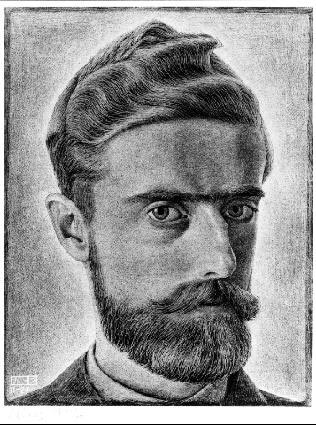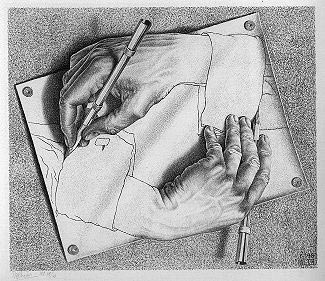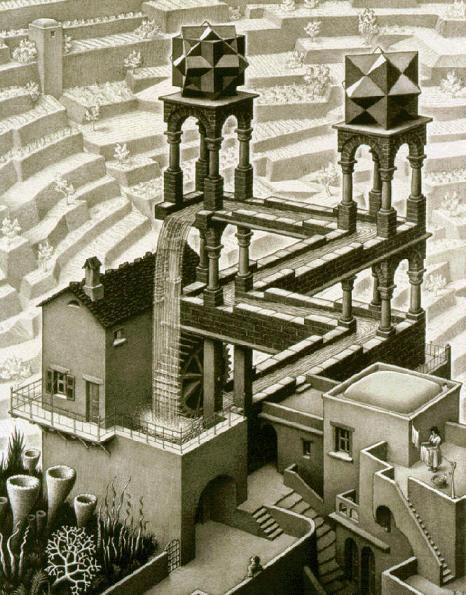| M.C. Escher | |
|---|---|
 |
|
| Photo by: Wikipedia, Creative Commons | |
| Born | June 17, 1898 Leeuwarden, The Netherlands |
| Died | Mar. 27, 1972 (at age 73) Laren, The Netherlands |
| Nationality | Dutch |
| Field | Drawing, Printmaking |
| M.C. Escher Famous Paintings | |
| The Waterfall, 1961 | |
| Relativity, 1953 | |
| Ascending and Descending, 1960 | |
| Drawing Hands, 1948 | |
| Sky and Water I, 1938 | |
| Three Worlds, 1955 | |
| House of Stairs, 1951 | |
| Belvedere, 1958 | |
| Another World, 1947 | |
| Complete Works |
Maurits Cornelis Escher, more popularly known as M.C. Escher, was born in the Netherlands on June 17, 1898. His father, George Arnold Escher, was a civil engineer, and his mother was Sara Gleichman. He was the youngest of 4 children. Maurits was a sickly boy, and although his grades were relatively poor, he did, however, excel in drawing. He took up piano lessons and classes in carpentry until the age of 13. He then went to the Haarlem School of Architecture and Decorative Arts in 1919, where he had initially studied Architecture but transferred to Graphic Arts after only one week. He left the school in 1922 after having gained knowledge on drawing and wood cutting.
Maurits then traveled extensively. In 1922, upon seeing the Alhambra, a 14th century Moorish castle, for the first time, Maurits became engrossed with the Regular Division of the Plane. This principle of plane division which is based on tessellation or tiling is the covering of a surface or plane with interlocking shapes. It was also during his travels when he met his wife, Jetta Umiker, in 1924. They resided in Rome but each year, Maurits would travel around Italy to draw and sketch which would serve as basis for his works. They had one son named Giorgio Arnaldo. World War II forced the family to return to the Netherlands. Maurits died at the age of 73 on March 27, 1972.
Maurits became famous for his works combining impossible reality, infinity, and tessellation. His first work was a woodcut print done in 1937 titled “Still Life and Street” which showed books resting on two adjacent buildings, a huge jar in the crossroads, and tiny dolls between the two buildings. During this time, Maurits became interested with the plane symmetry groups after his brother sent him an academic paper by George Polya about the said concept. He since then applied some mathematical approach in expressing symmetry in his works.
“Sky and Water” was another woodcut print (he also did a lithograph print) done in 1938 which made use of birds and fish to depict the Regular Division of the Plane. This has been used in many science classes to illustrate visual perception. Maurits continuously made a series of drawings using this concept until the 1960s.
“Metamorphosis” was a three-part series of woodcut prints Maurits created wherein he created an image using tessellation then gradually changing the pattern to create a whole new image altogether. The first series was done in 1937, the second between 1939 and 1940, and the last one, which was presumed to be Maurits’ largest print, was done between 1967 and 1968.
“Reptiles” was a lithograph printed in 1943 which again made use of the concept of the Regular Division of the Plane with patterns of reptiles on a paper then becoming alive as it crawls around the table. This particular print was used by a rock band named Mott the Hoople for the cover of their first album released in 1969.
“Three Spheres II” was a depiction of three spheres with the leftmost sphere being transparent but with light being refracted onto the surface, the middle showing a reflection of Maurits drawing, and the rightmost sphere being opaque. It was printed in 1946.
“Drawing Hands” depicted two hands drawing each other into existence. This was Maurits most obvious play on paradoxes and it was printed in 1948
“Gravitation” is probably Maurits’ first work using mixed media. He had initially created it as a lithograph print in black and white, then later used watercolor. It was printed in 1952, and it showed a small stellated dodecahedron, each with a door, from which protruded the heads of turtles.
“Relativity” which Maurits created in 1953 is his most popular creation. It was a lithograph representation of three-dimensional figures existing in a two-dimensional world. The print consisted of six stairs belonging to different fields of gravity, and there were figures going up and down these stairs.
Other popular lithographs are “Convex and Concave” done in 1955, and “Belvedere” done in 1958.
“Ascending and Descending” was a lithograph print done in 1960 inspired by the Penrose stairs. This concept of a staircase making four turns in a never-ending ascending and descending loop was created by Lionel Penrose in 1958. In “Ascending and Descending”, Maurits copied this impossible staircase, placed it on top of a large building, and embedded it with a variety of human activities.
With “Waterfalls” done in the following year, Maurits further developed the Penrose stairs by making use of an aqueduct. The water could be seen in perpetual motion with the help of a waterwheel but the paradox was created by using conflicting proportions.
Maurits’ created a total of 448 woodcut prints, lithographs, and even wood engravings. Although he had made several works which had already shown early experimentations with impossible realities as early as the 1920s, Maurits considered paintings he did before 1935 as worthless. But these early works, together with all his others works, continue to amaze millions of people all over the world.


